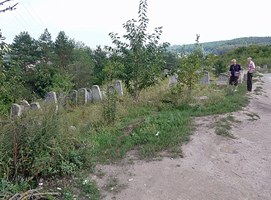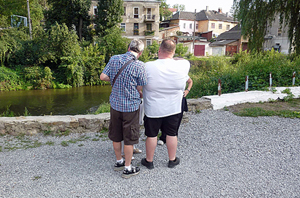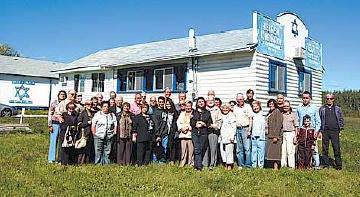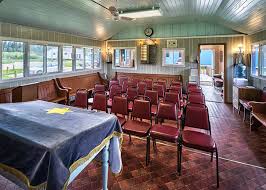Features
Return to Ukraine: searching out the Rosner family past

Introduction: Not too long ago we were contacted by former CBC Manitoba managing editor Cecil Rosner, who asked us whether we’d be interested in publishing a story about a trip he took in 2012 to visit the area in Ukraine where both his parents were born. Although it’s been 10 years since Cecil visited Ukraine, given the current situation in that country we thought it timely to get a sense of what life was like in Ukraine prior to the Russian invasion.
By CECIL ROSNER ““Oi — look at the way the schlemiel drives.”
We are bouncing along the potholed roads of Western Ukraine, heading from Lviv to my mother’s hometown of Buczacz. Our driver and guide isn’t Jewish, but that doesn’t stop him from endlessly whistling Fiddler on the Roof tunes and inserting Yiddishisms into every second phrase.
“These guys are all ganefs (thieves),” he says of the policemen we pass, as he forms his thumb and forefinger into a pistol and slowly pulls the trigger. Alex doesn’t like the speed traps the highway patrols set up, and he appreciates oncoming drivers signalling him to beware of cops just beyond the next hill. It’s an important issue for our driver, who crisscrosses Ukraine’s roads all year-long, ferrying tourists to distant towns and villages in search of their Jewish ancestors.

For Alex, who holds a history degree and is an expert at tracing genealogical roots, it’s an occupation he never dreamed he would have. But in the chaos of the Soviet Union’s collapse, when jobs were evaporating and everyone was trying to reimagine their lives, it seemed like a useful niche to pursue – especially as foreigners were finally trying to discover exactly what had happened to their relatives during the Second World War.
That’s why I’m here too, along with my wife and a cousin. Both of my parents were born in the region, and both were here when the Nazis occupied the area in 1941. In different improbable and miraculous ways, they both survived the war and emigrated to Canada. But every single other family member was shot, gassed, beaten or starved to death by the Nazis and their collaborators. We came here to see what traces of their lives remained.
It seemed logical to make our first stop the local museum, right across from the old city hall. Buczacz is little more than a village, with about 13,000 people. In the early part of the 19th century, Jews made up two-thirds of the population. While that number ebbed and flowed over the years, Jews were still in the majority when the Nazi occupation began. But that would have been difficult to discern in the museum.
In all the display cases, and in the colourful photo album that the town produces, there is no specific mention of a Jewish population. There is scarcely any reference to the Second World War, except for a notation that the town “was released from German invaders and captured by the Soviet Union.” Wouldn’t a town’s museum want to address what became of the majority of the population? What happened to thousands of farmers, shop owners, tailors, tinsmiths, doctors, lawyers and politicians? Doesn’t the mass roundup and extermination of most people in town even rate a mention?
The only hint of any Jewish presence came in the form of artifacts from the life of Shmuel Agnon, a Jewish writer born in Buczacz who won the Nobel Prize for literature. But the entire fate of the people Agnon wrote about had been erased.
Alex had little luck getting the museum’s employee to throw any light on what the town was like in the immediate pre-war period. She genuinely seemed not to know. But there were a few things I already knew.
My mother, Mina, had been born here in 1913, and her family owned a wholesale distribution company. They carbonated water and stored it in big, forty-litre copper cylinders, shipping them along with ice to shops throughout the area. When she was 25, she married my father, Michael Rosner, who came from nearby Kolomaya. In 1939, they opened a small retail store on the main town square, probably within metres of the present-day museum.
When the war broke out in September 1939, there was a reprieve. The region came under the control of the Soviets, and Jews were under no immediate threat. All that changed when Hitler marched eastward in 1941. My father was conscripted by the retreating Soviets, and my mother was trapped behind Nazi lines for the remainder of the war.

For the next three years, every member of my mother’s family – her parents, five brothers and sisters, aunts and uncles and cousins – were dragged from their hiding places, bludgeoned or shot, or sent off to be executed. They were all dumped into unmarked graves. My parents’ first-born child – my brother – also fell victim, dying at the age of three in 1942.
My mother’s survival defied any normal odds. She fled from one hiding place to another, escaping just in time to avoid capture. She spent 11 months in the attic of a Polish family along with five other Jews. She took an assumed name and boldly convinced the Nazis she was Christian. Finally, after Buczacz was liberated, she re-united with my father and they came to Canada to start anew in 1948.
I had been to Buczacz once before, with my mother, in 1990. We came with a documentary crew to record her first visit back home since the war. It was an emotional trip and a difficult one for both of us. But we learned very little of the actual events that had transpired in the town, or the exact locations where they happened. That’s why, nearly 15 years after my mother’s death, I was returning for a second time.
I convinced Alex that our best strategy on this trip would be to find older people and ask them what they knew about the 30s and 40s. Alex seemed skeptical. For one thing, the war had begun more than 70 years ago, so it was unlikely there would be any useful first-hand witnesses at hand. And there was also the collective amnesia that pertained to inconvenient truths.
After all, a segment of the population had actively collaborated with Hitler. They were instrumental in helping identify and round up the Jews, the Communists, and all the other elements the Nazis wanted to destroy. Some might still be living in Buczacz and surrounding areas. Their children and grandchildren almost certainly are here.
The museum’s employee finally gives us a sliver of hope. There is someone in town we should visit – someone who knows the history and might be able to help us. His name is Mykola.
We drive for a few minutes and stop at Mykola’s house. I am expecting to find an elderly man who may have been a teenager during the war. Instead, we come upon a 40-something man in sweatpants and a Maple Leafs T-shirt. He is clutching a handful of papers and photographs. One of them shows a photo of Buczacz’s surviving Jews standing beside a memorial gravestone in 1944. Out of the original population of 10,000, no more than 100 survived. One of the people in the photo is my mother.
Mykola has taken an interest in wartime history, and now helps visiting tourists locate family remnants. He has a variety of interesting documents, including a map of pre-war street names, and a mid-19th century register of townsfolk. It turns out that he knows about some of the Jewish families that lived in Buczacz during the war – a handful of them have returned over the years, and he has helped them find their old homes and landmarks.
We ask Mykola if he could help solve a puzzle my mother and I couldn’t figure out on our previous trip. Her family had lived on a street called Zeblickevicie, which had changed names several times after the war. From her description, though, we knew it was beside a stream that ran into the Strypa River, a subsidiary of the Dniester.
We pile into the car along with Mykola and he directs us to the location. The stream had been covered over, except at the point where it emptied into the Strypa. Though the original home was no longer there, he shows us the exact location where my mother’s family had lived. I saw the idyllic surroundings, the lush vegetation around the quiet river, and for the first time I had an inkling of the peaceful life my mother experienced before the war changed everything.
While we were all walking along the old Zeblickevicie street, Mykola bumps into a friend and exchanges a few words with him. As we walk on, the friend stops my wife, Harriet, and our cousin Nina and says: “Mina Rosner – I am a Witness.” That is the name of my mother’s book. Alex is impatient. He had rich experience of locals trying to pester visitors, and he was eager to move us all along. But Harriet and Nina persist. It turns out the man on our chance encounter knows all about my mother’s story, and offers to take us on a tour of where she lived, where she went to school, where she hid during the war, and where her family members were killed.

Over the next 24 hours, Alex grudgingly admits he was wrong. Our serendipitous encounter has linked us up with Jura, a 60-year-old retired computer technician, astrologist and local historian. He knows my mother’s exact birthdate, and, it appears, everyone else’s in town. He has a photocopied version of my mother’s book, and he has pieced together her recollections with precise locations of many of the events she describes. If photographic memories actually exist, we figure he has one. He is a visiting tourist’s dream come true, and Alex has to take a back seat while Jura takes us on a remarkable tour of my mother’s life.
The first stop is just around the corner, on a street that used to be called Chechego Maya. I remember it from my mother’s stories, but we could never pinpoint it on our previous trip. Jura shows us the building where my mother’s sister and her husband ran a hardware shop. He knows the address because it’s listed in trade publications of the era. Though my mother’s original house and her parents’ store no longer existed, I finally had an authentic touchstone of some of her family’s life at the time.
Jura takes us to the pre-war building on Kolejowa Street that served as the cheder, the religious school, where Jewish kids studied. We visit the girls’ school and middle school where my mother was a student, and walk into Buczacz’s Sokol theatre, where she watched dramatic performances and movies as a teenager. A group of children is rehearsing a musical concert on stage, and I can imagine my mother sitting in the auditorium with her brothers and sisters and friends.
Just down the road, near an orchard, Jura shows us the garden of a long-ago demolished home where my mother hid during one of the Nazi aktions, or periodic killing sprees. A bunker had been constructed in the cellar, and this helped shield her and other Jews from capture. The Nazis conducted four major aktions during their occupation of Buczacz before declaring the town Judenrein, or completely free of Jews. But the declaration turned out to be false. My mother, along with dozens of others, managed to survive with the aid of courageous gentile families who risked their safety to shelter them.
In the middle of our travels, Jura pulls out a sheet of typewritten names – people who had served as policemen, gendarmes and SS officers during the war. I recognize some of the names. Some of the Nazi war criminals and their collaborators have been brought to justice, but the vast majority remain undetected and untried for their crimes.
We go to the Jewish cemetery, where many of the town’s Jews – including my mother’s parents – were taken to be executed. The place is untended and overgrown, a jumble of brush and junk, with headstones in various states of disrepair. We find my great-grandmother’s grave. It’s significant, because two plots over my mother buried her first-born child, Isaac, in an unmarked plot. I clear away the branches and debris from the group of headstones in the area to get a better view. I bend down and touch the ground where the brother I never met is buried. Exactly 70 years later, someone has come back to this place to remember.
Jura takes me down a path through brambles to a spot where survivors had erected a memorial to the war’s victims. The place is overgrown with trees and bushes now, but he says there was nothing here before the war. The marker no longer survives, and even if it did, it’s unlikely anyone would be able to find it without an expert guide.
Our next stop is Fedor Hill, another killing ground where thousands perished. It’s difficult to see traces of anything here, but Jura once again guides us to a marker commemorating the killing of 450 people during the early days of slaughter in 1941. It had been erected by a survivor’s family well after the war.
A far more prominent memorial on Fedor Hill is dedicated to the UPA, the Ukrainian Insurgent Army, the military wing of a movement that initially collaborated with the Nazis in hopes of winning an independent homeland. In fact, throughout our travels in Western Ukraine, there were numerous new memorials to Ukrainian nationalist fighters in places where it might have been logical to place markers noting the victims of the Nazi era. We saw this on the side of a synagogue in Ivano-Frankivsk, near the Jewish ghetto entrance in Lvov, and many other places. In my father’s hometown of Kolomyia, it was a similar story — no mention of Jews or Nazi victims in the local museum, no remnants of the huge Jewish population, and a patriotic memorial to Ukrainian nationalist figures on the site of a former synagogue. In the re-written history of today, the UPA and its related Organization of Ukrainian Nationalists are presented as groups that fought both Soviets and Nazis; no mention is made of the collaboration in 1941 that led to so much destruction during the war.
Throughout our trip to Ukraine, we were reminded of the upcoming election campaign and the ever-present imagery of Ukrainian nationalism, especially in the Western part of the country. In a land that was exercising its brand of democratic activity, we had to wonder how thoroughly the country had come to grips with its recent history. Many countries are wrestling with related questions, trying to reconcile horrendous events of the past with a way forward. But as in any process or truth and reconciliation, there needs to be an initial recognition of what took place. Erasing and denying the past is rarely the path to building a healthy future.
At the end of our tour in Buczacz, Jura wanted to know the exact date of my mother’s death. He also was interested in our birthdates and any other information he could glean from us. In a country that chooses to forget so much, he was something of an anomaly.
Features
Japanese Straightening/Hair Rebonding at SETS on Corydon

Japanese Straightening is a hair straightening process invented in Japan that has swept America.

Features
History of the Winnipeg Beach Synagogue: 1950-2025

By BERNIE BELLAN The history of the Winnipeg Beach Synagogue is a fascinating one. We have had several articles over the years about the synagogue in The Jewish Post & News.


In June 2010 I wrote an article for The Jewish Post & News upon the 60th anniversary of the synagogue’s opening. Here are the opening paragraphs from that article:
“Sixty years ago a group of Winnipeg Beach vacationers decided that what their vacation area lacked was a synagogue. As it happened, a log cabin one-room schoolhouse in the Beausejour area happened to be available.
“In due course, the log cabin was relocated to the corner of Hazel and Grove in Winnipeg Beach, where it stayed for 48 years.”

In December 1994 my late brother, Matt, wrote a story about the spraying of antisemitic grafitti on the synagogue which, at that time, was still situated at its original location on the corner of Hazel and Grove in the town of Winnipeg Beach:
“Two 16-year-olds spraypainted slogans like ‘Die Jews,’ ‘I’ll kill you Jews,’ and other grafitti in big letters on the beach synagogue.
“Jim Mosher, a news reporter for the Interlake Spectator in Gimli, said last Halloween’s vandalism against the synagogue wasn’t the first. In the late 1980s, he claimed, it was spraypainted with swastikas.
“Jack Markson, a longtime member of the Winnipeg Beach Synagogue, last week also said he could remember finding anti-Semitic grafitti spraypainted on the synagogue ‘a few years ago,’ and at least twice in the 1970s, when the cottage season was over.”

My 2010 article continued: “In 1998 the Town of Winnipeg Beach informed the members of the synagogue that the building would have to be hooked up to the town’s sewer and water system. Rather than incur the cost of $3-4,000, which was thought to be ‘prohibitive,’ according to longtime beach synagogue attendee Laurie Mainster, synagogue goers looked elsewhere for a solution.
“As a result, the board of Camp Massad was approached and asked whether the synagogue might be relocated there, with the understanding that the synagogue would be made available to the camp at any time other than what were then Friday evening and Saturday morning services.
“Over the years the ‘beach synagogue’ had come to be a very popular meeting place for summertime residents of Winnipeg Beach and Gimli. In fact, for years minyans were held twice daily, in addition to regular Saturday morning services. Of course, in those years Winnipeg Beach was also home to a kosher butcher shop.
“While the little synagogue, which measured only 18 x 24 feet, has gone through several transformations, including the move to Camp Massad, and the opening up to egalitarian services in 2007 (The move to egalitarian services was as much a practical necessity as it was a nod to the equality of women – the only Kohen present at the time was a woman!), it has always remained cramped at the best of times.

“In recent years the synagogue has seen the addition of a window airconditioner (although to benefit from it, you really have to be sitting just a few feet away), as well as a fridge that allows synagogue attendees to enjoy a regular Saturday morning Kiddush meal following the service.
“According to Laurie Mainster, the Saturday morning service has continued to be popular, even though many of the attendees now drive in from Winnipeg, as they have sold the cottages they once maintained.
“On the other hand, one of the side benefits to being located on Camp Massad’s grounds has been an infusion of young blood from among the camp counsellors.
“Since there is no longer a rabbi available to conduct services (Rabbi Weizman did lead services for years while he had a cottage at the beach), those in attendance now take turns leading the services themselves.
“Anyone may attend services and, while there are no dues collected, donations are welcome. (Donations should be made to the Jewish Foundation of Manitoba, with donors asked to specify that their donations are to be directed to the beach synagogue.)
“Mainster also says that the beach synagogue is now undergoing an expansion, which will be its first in 60 years. An entirely new space measuring 16 x 18 feet is being added – one that will allow for a real Kiddush area. (Until now, a table has been set up in the back of the synagogue and synagogue goers would help themselves to the buffet that is set up each Saturday during the summer. While pleasant enough, it will certainly be more comfortable to have an actual area set aside for the Saturday afternoon after service lunch.)
“As for dress, longtime attendee Abe Borzykowski (in an article written by Sharon Chisvin for the Free Press in 2007) remarked that ‘I don’t think there are many synagogues where people can attend in shorts, T-shirts and sandals and not feel out of place.’ “

As mentioned in that 2010 article, the beach synagogue at that time was about to undergo an extensive remodelling. Here is an article from a January 2011 issue that describes that remodelling process. The article was written by Bernie Sucharov, who has been a longtime member of the beach synagogue:
“The Hebrew Congregation of Winnipeg Beach made a major change to the synagogue this past summer. With the help of many volunteers, Joel Margolese being the project manager, the synagogue was expanded and an addition was built to handle the overflow crowds, as well as to add more space for the kiddush following services.
“The volunteers spent many Sundays during the summer months building the addition. Bad weather caused many delays, but finally the addition was completed one week before the official summer opening.
“The volunteers were: Joel Margolese, Gordon Steindel, Sheldon Koslovsky, Viktor Lewin, Harvey Zabenskie, Nestor Wowryk, Kevin Wowryk, Victor Spigelman, Jerry Pritchard, and David Bloomfield.
“On Sunday, June 25, 2010 a special ceremony was held to affix a mezzuzah to the front entrance door. Gordon Steindel had the honour of affixing the mezzuzah, which was donated by Sid Bercovich and Clarice Silver.
“Refreshments and food for the day were prepared by Phyllis Spigelman, also known as our catering manager. Throughout the summer, Phyllis, Lenore Kagan and other friends prepared the food for our kiddush.
“A sound system was donated by Arch and Brenda Honigman in memory of their father, Sam Honigman z”l. “The system was installed by Joel Margolese and Stevan Sucharov. This will allow the overflow crowd to hear the service in the new addition.
“There were also generous donations of 50 chumashim and an air conditioner. The chumashim were donated by Gwen, Sheldon and Mark Koslovsky. The air conditioner in the new addition was donated by Joel and Linda Margolese.
“The official opening of the synagogue for the summer took place on July 3, 2010. We had an overflow crowd of 70+ people.”

Since that 2010 major addition to the synagogue, it has also added a wheelchair ramp (although I’ve been unable to ascertain exactly when the ramp was built). Also, the synagogue also has its own outdoor privy now. (Attendees used to have to use facilities in Camp Massad.)
And, as already noted in article previously posted to this site (and which you can read at Beach Synagogue about to celebrate 75th anniversary), in recognition of that occasion, on August 2nd members of the synagogue will be holding a 75th anniversary celebration.
As part of the celebration anyone who is a descendant or relative of any of the original members of the first executive committee is invited to attend the synagogue that morning.
If you are a relative please contact Abe Borzykowski at wpgbeachshule@shaw.ca or aborzykowski@shaw.ca to let Abe know you might be attending.
Features
Kinzey Posen: CBC Winnipeg’s former “go-to guy”

By GERRY POSNER If former Winnipegger Lawrence Wall was the CBC go-to guy in Ottawa, CBC Winnipeg had its own version of a go-to guy for many years with none other than the very well known Kinzey Posen. Of course, many readers will recognize that name from his career with Finjan, the Klezmer group so famous across Canada and beyond. It has been written about Posen and his wife Shayla Fink that they have been involved in music since they got out of diapers. And, as an aside, their love and ability in music has now been transmitted to the next generation as in their son, Ariel Posen (but that’s another story).
Kinzey Posen (not to be confused with Posner, or maybe we are to be confused, but who knows for sure?), was a graduate of Peretz School, having attended there from nursery right until Grade 7, graduating in1966. That was followed by Edmund Partridge and West Kildonan Collegiate. Musically, he was in large part self taught. However, he did have some teachers along the way. After moving to Vancouver – from 1974-78, he had the chance to study acoustic classical bass with a member of the Vancouver Symphony Orchestra. When Kinzey lived in Vancouver, he also worked as a jazz musician.
Upon returning to Winnipeg, Kinzey enrolled as a mature student at the University of Winnipeg, where he obtained a Bachelor of Urban Studies degree. Although the degree was in no way connected to the career that followed, his attending the University of Winnipeg was critical to his connecting with the CBC. Why? you ask. Kinzey had a position after graduation working for the Institute of Urban Studies. While there, he met someone who invited him to work for the Department of Continuing Education as one of their program directors. At the time the Department of Continuing Education was located at 491 Portage Avenue, which was also known as the TJ Rice Building. The CBC also leased some space in the same building. According to Kinzey, the CBC part of the building “included HR, different shows and other support offices. Continuing Education was located in the basement and main floor and that’s where I worked.”
KInzey had long had an interest in the CBC, which made the fact that the CBC had some offices in the same building where he was working serendipitous. That Kinzey might be interested in visiting the CBC was not an accident. As a young boy he had a nightly connection to CBC, as it was his ritual to listen to CBC Radio (as well as all sorts of other radio stations across the USA) on his transistor radio every night in bed. He became enamoured of one particular CBC host, Bill Guest, so that when going to sleep, he imagined that he was Guest doing interviews with imaginary guests. That dream of working for CBC became a reality when he had a chance to do a one week gig with Jack Farr’s network program.
Kinzey took a week off from his Continuing Education job and spent five days at the CBC. That week was a training session for Posen, as he had to create ideas, research, pre-interview, write the script, and set up the studio for Farr’s interview. He was almost in his dream job – although not quite – since it was only for one week. His opportunity, however, came in 1988, when he was offered a one-year term as a production assistant – the lowest guy on the ladder, for a show called “ Simply Folk,” with the late Mitch Podolak as the host. Although he was indeed at the bottom as far as those working on the show were concerned, he took a chance and gave his notice to the U of W. The rest is history. In his new job, Kinzey learned how to become a producer. Lucky for him, at the end of the year, when the person he replaced was supposed to come back, she never returned (just like the song, “MTA,” by the Kingston Trio). At that point, Kinzey was hired full time at the CBC.
Kinzey was a fixture at the CBC for 27 years. During those years, Kinzey had the chance to work with Ross Porter, a respected former CBC host and producer, also with Karen Sanders – on the “Afternoon Edition.” One aspect of Kinzey’s job on the Afternoon Edition was to come up with ideas, mix sound effects, arrange interviews and music, to create a two-hour radio experience. In addition, he covered jazz and folk festivals and, as a result, was exposed to some of the best musicians in the world. With Ross Porter in the 1990s, he worked on a network jazz show called “ After Hours,” which was on from 8-10 PM five nights a week. Kinzey was involved with writing the scripts, picking the music, and recording the shows, as well as editing them and then presenting them to the network for playback.
Of course, over his career, Kinzey had many memorable moments. He told me about one of them. The story revolved around the National Jazz Awards one year in particular. The awards were to be broadcasted after the National News which, in those days, began much earlier in the evening, and were over by 8:00 pm. The legendary Oscar Peterson was lined up to play a half hour set at the awards, starting at 7:30. But, as Kinzey told me, Oscar Peterson had a “hate on” for the CBC ecause one of his recorded performances was wrongly edited and he refused to appear on CBC under any circumstances. As the time neared 8:05 PM, which was when the CBC was to begin its broadcast of the jazz awards, it became apparent that Oscar was not going to finish on time. As the producer of the awards show, Kinzey was tasked with telling Oscar Peterson to wrap it up and get off the stage. There was Kinzey Posen, a huge fan of Oscar Peterson, now faced with the prospect of telling Oscar – while he was still playing – with 500 people in the audience, to stop and get off the stage. Not often was or is Kinzey Posen frozen, but that was one such moment. There was one loud “Baruch Hashem” from Kinzey when Oscar completed his set literally just in time.
Clearly, Kinzey was part of a very successful run with After Hours as it was on the air for 14 years. It was easily one of the most popular shows on CBC Radio 2, and a winner of several broadcasting awards. Kinzey also played a major role in producing a two part documentary about legendary guitarist Lenny Breau.
When After Hours ended, Posen became one of the contributing producers to Canada Live and specialized in producing live radio specials for the network, such as the Junos, for CBC Radio One and Two. Needless to say, his career planted Posen in the world of some top notch musicians, including his time spent working with Robert Plant (Led Zeppelin), Dave Brubeck, Randy Bachman, Chantal Kreviazuk and a list of prominent names in the Canadian, American and European music spheres. Locally, the CBC came to refer to Kinzey as the Jewish expert. I would add music expert to that title.
After his 27 year run at the CBC – and before he fully retired, Kinzey went on to work for the Rady JCC as a program director for a year and a half. Of course, to say that Kinzey Posen is retired is a major contradiction in terms. You really can’t keep him down and he has his hand in a variety of programs and projects – most of which he remains silent about, as is his style.
When I realized the full depth and talent of Kinzey Posen, I quickly concluded that he must certainly be related to me. Even if he isn’t, I now tell people he is.
